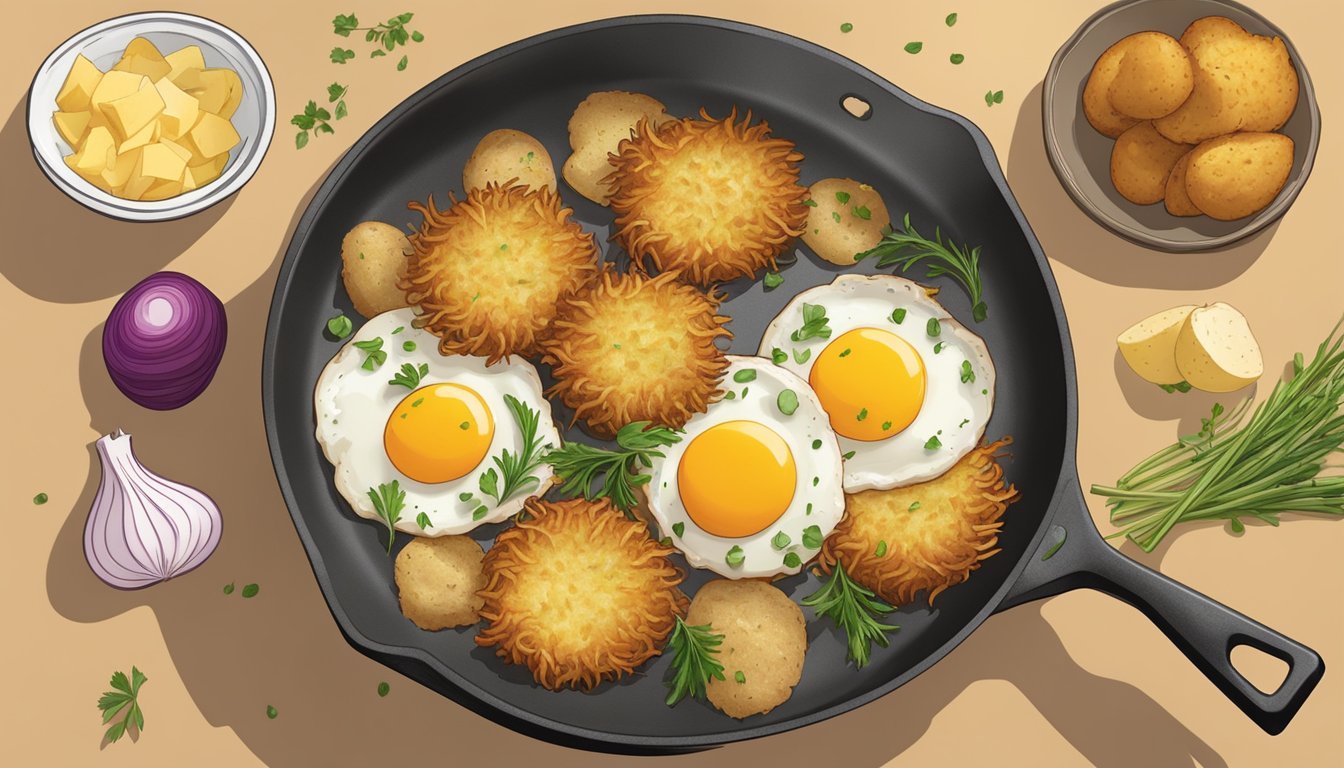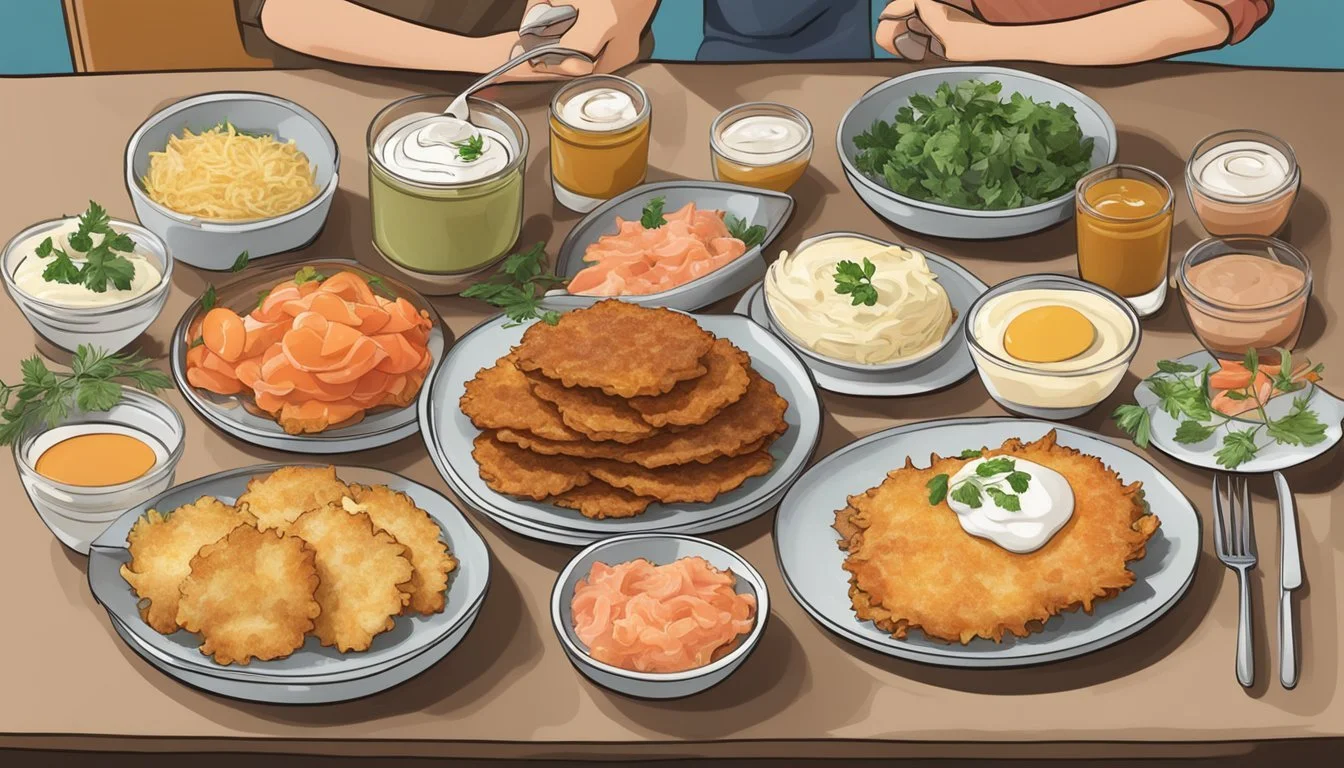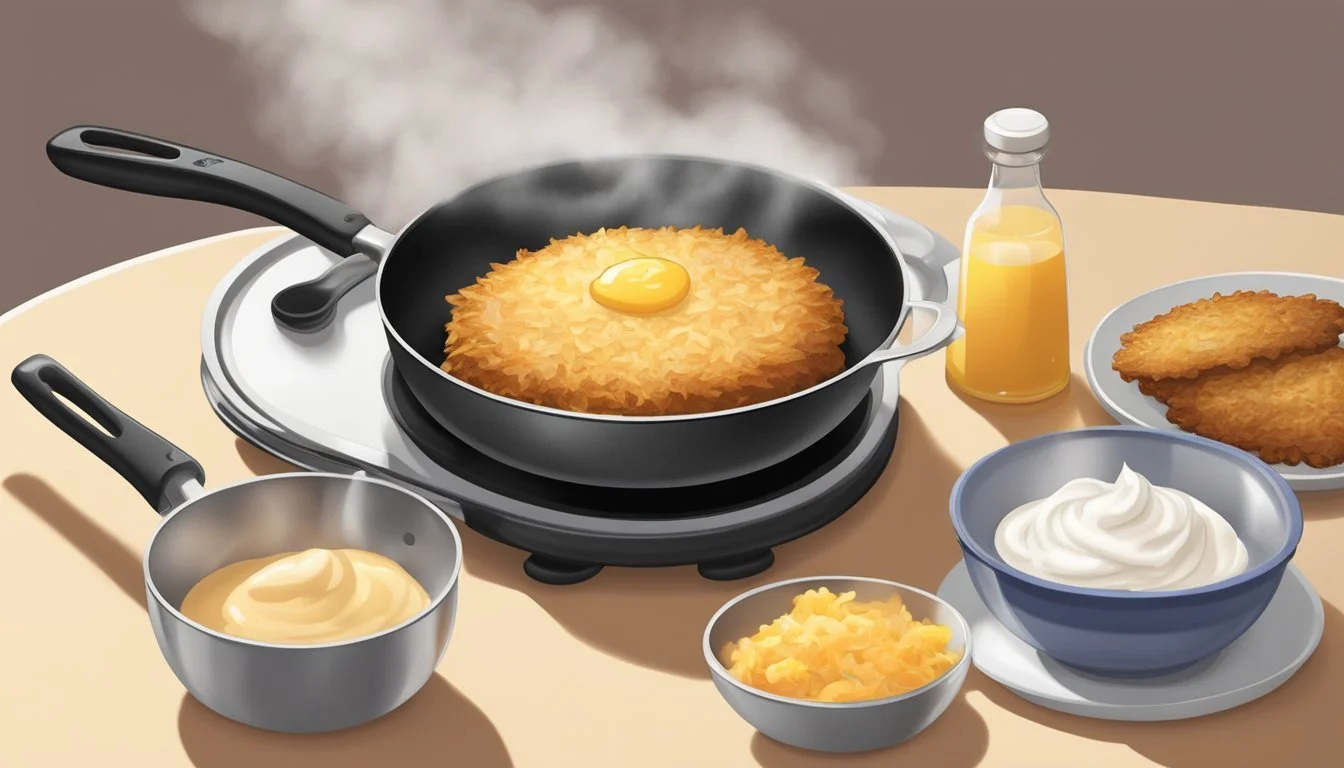Are Latkes Gluten-Free?
Determining the Dietary Compatibility of This Classic Dish
Latkes, the traditional potato pancakes commonly associated with Hanukkah, create a culinary conundrum for those adhering to gluten-free diets. Typically, latkes are made from grated potatoes (What wine goes well with potatoes?) and onions, mixed with eggs, flour, and seasonings before being fried to a golden crisp. The flour, acting as a binder, is a key ingredient that traditionally contains gluten. This poses a problem for individuals with celiac disease or gluten sensitivity, as consuming gluten can lead to adverse health effects.
The question of whether latkes are inherently gluten-free depends on the preparation. In their most authentic form, they would not be suitable for a gluten-free diet due to the use of wheat flour. However, the flexibility of the latke recipe allows for easy modifications to cater to dietary restrictions without compromising on taste or texture. Gluten-free flours, such as white rice flour or arrowroot flour, serve as excellent substitutes, offering a way to maintain tradition while accommodating the gluten-free community.
As Hanukkah celebrations involve enjoying these crispy delights, it is imperative to be aware of the ingredients to ensure they align with dietary needs. Modern renditions of the recipe show a trend towards inclusivity, demonstrating that with minor adjustments, latkes can be a part of the festive fare for everyone, regardless of dietary restrictions. The growing awareness and availability of gluten-free alternatives have made it easier to enjoy latkes without gluten, ensuring that this Hanukkah staple remains a joyous part of the holiday season.
What Are Latkes?
Latkes are a traditional Jewish dish, particularly associated with the celebration of Hanukkah. They are crispy potato pancakes that have been enjoyed for centuries.
Historical Significance
Latkes hold a place of honor in Jewish cuisine, with their roots in the history of Hanukkah. They are a symbol of the oil that miraculously burned for eight days in the Jewish Temple, which is why they are fried. Originally, latkes may have been made from cheese or other ingredients, but potatoes became the staple ingredient due to their availability and affordability in Eastern Europe.
Basic Ingredients
The basic ingredients for traditional latkes are:
Potatoes: The star of the dish, providing the starchy base.
Onions: Grated and mixed with the potatoes for flavor.
Eggs: Act as a binder to hold the latke mixture together.
Oil: Used for frying, creating the latke's characteristic crispy exterior.
These ingredients are combined to form a batter, which is then shaped into small pancakes and fried until golden brown.
Traditional Recipes and Variations
Traditional latkes are a simple yet versatile dish. The essential method involves:
Grating the potatoes and onions.
Squeezing out excess moisture.
Mixing with eggs and seasoning.
Frying in hot oil.
Variations of latkes have evolved over time, including gluten-free options that substitute flour with potato starch or other gluten-free alternatives. Some cooks add additional ingredients for flavor or texture, such as garlic, chives, or even carrots. Despite these variations, the goal remains to achieve a savory, golden-brown pancake that is crispy on the outside and tender on the inside.
Determining Gluten Content
One must scrutinize ingredients and preparation methods to ascertain the gluten content in latkes. This section outlines what gluten is, identifies common sources of gluten in traditional latkes, and suggests suitable gluten-free ingredient substitutions.
What Is Gluten?
Gluten refers to a group of proteins found in certain grains. It imparts elasticity and chewiness to doughs and batters. Although gluten is harmless for most individuals, those with celiac disease or gluten sensitivity must avoid it to prevent adverse health effects.
Common Sources of Gluten in Latkes
Traditional latkes may contain gluten through ingredients like flour or matzo meal, which act as binders. These are derived from gluten-containing grains such as wheat, barley, and rye.
Flour: Often used to give latkes their structure.
Matzo meal: A common Passover ingredient, it is essentially ground matzo, which is made from wheat.
Gluten-Free Ingredients Substitutions
For gluten-free latkes, it's vital to use alternatives that mimic the binding properties of gluten without the associated proteins.
Gluten-Free Flour: A mixture of gluten-free grains and starches provides similar binding qualities.
Potato Starch: Extracted from potatoes, it lends crispiness to latkes.
Arrowroot Flour: Another gluten-free option that can help achieve the desired texture.
Using these substitutes ensures that the latkes remain gluten-free while still providing the traditional taste and texture.
Preparing Gluten-Free Latkes
Making gluten-free latkes successfully involves selecting appropriate gluten-free ingredients, using specialized cooking techniques, and focusing on achieving the desired texture and flavor.
Ingredient Selection
For gluten-free latkes, the choice of potatoes is crucial. Starchy varieties like russet potatoes and Yukon gold potatoes are often preferred for their ability to create a crispy texture. The traditional ingredient, wheat flour, is substituted with alternatives such as white rice flour or arrowroot flour to maintain the structure without adding gluten. The addition of a finely grated onion provides a sharp counterbalance to the potato's richness. Moreover, one must ensure that all ingredients, including baking powder or any seasonings, are certified gluten-free to avoid cross-contamination.
Cooking Techniques
To achieve the characteristic golden brown and crispy edges of gluten-free latkes, frying is the key method. The oil (canola, vegetable, or any high-heat oil) should be heated in a skillet until shimmering but not smoking. Consistent medium heat is vital to ensure the latkes cook thoroughly without burning. Portioning the mixture and pressing it into patties ensures even cooking. A common practice is to press excess moisture from the mixture before frying to enhance the crispiness of the latkes.
Texture and Flavor Considerations
The texture of latkes is paramount. Achieving a crispy exterior while maintaining a tender interior is the hallmark of a good latke. Mixing the ingredients until just combined, without overworking, aids in preserving the potato's natural texture. Additionally, the use of proper gluten-free binders helps the latkes hold together during cooking. For flavor, the balance of seasoning with just the right amount of salt and pepper can bring out the earthiness of the potatoes and the pungency of the onions. Serving with complementary condiments like sour cream or apple sauce further enhances the flavor profile of gluten-free latkes.
Pairings and Toppings
Latkes are versatile in terms of pairings and toppings, presenting a range of flavors that can accentuate the dish. Whether one prefers a tangy kick or a sweet note to complement the savory potato base, there are numerous options to explore.
Savory Options
For those who enjoy a more savory addition, traditional toppings include:
Sour cream: A classic choice, sour cream balances the dish's richness with its cool and creamy texture.
Applesauce: While a sweeter option, applesauce is a traditional pairing that offers a light contrast to the savory pancake.
Chives: Fresh chives bring a mild onion-like flavor that complements the latke without overpowering it.
Cream cheese: For a richer experience, cream cheese can be a decadent topping, especially when combined with fresh herbs.
Additionally, one can introduce Mediterranean flavors with tzatziki, a cucumber and yogurt-based sauce, or pesto for a herby touch.
Sweet Additions
To satisfy a sweet tooth, these condiments can be delightful:
Applesauce (sweet): It provides a fruity and mildly tangy flavor that pairs well with the saltiness of the latkes.
Sugar: A light sprinkling of sugar over latkes can enhance their golden crispness with a hint of sweetness.
It is often balanced with a pinch of salt to enhance the sweet and savory combination.
Creative Topping Combinations
Innovative topping combinations can transform the latke experience. Here are some suggestions:
Sour cream with pesto: A dollop of sour cream with a drizzle of pesto unites creamy and fresh.
Applesauce with a sprinkle of cinnamon: This pairing combines the traditional applesauce topping with a warm spice twist.
Cream cheese with chives and black pepper: This combo provides a creamy spread with an aromatic kick from the fresh chives and sharpness of black pepper.
Toppings should be applied with care to not overwhelm the inherent flavor of the latkes themselves.
Latke Serving and Storage
Proper serving and storage of latkes ensure that they maintain their crispy and golden-brown texture that is so desirable in this classic pancake. By following these guidelines, one can enjoy latkes at their best both when fresh and as leftovers.
Best Practices for Serving
Latkes are best served immediately after cooking, as they are at their crispiest when fresh out of the frying pan. To absorb any excess oil and retain crispiness, one should place the latkes on a plate lined with a paper towel before serving. It's important to serve latkes at a comfortable yet warm temperature to enhance their flavor and texture.
Storing Leftovers
When storing leftovers, it is crucial to let the latkes cool to room temperature before placing them in an airtight container. They should be separated by parchment paper to prevent sticking, and can be stored in the refrigerator for up to 3 days.
Reheating for Optimal Texture
To recapture the crispy texture, leftovers should be reheated in an oven preheated to 350°F (175°C). One can spread the latkes on a baking sheet and heat them for about 5-10 minutes or until they are heated through and crispy. Microwaving is not recommended as it can make the latkes soggy.
Nutritional Considerations
Latkes, a traditional Jewish potato pancake, offer a range of nutrients. Their nutritional profile varies based on ingredients and cooking methods.
Calories and Macronutrients
Calories: Traditional potato latkes are typically fried, contributing to their higher calorie count. Each latke can range from 70 to 200 calories depending on its size and the amount of oil used.
Macronutrients:
Protein: Potatoes are not a significant source of protein; thus, latkes generally contain low amounts of protein.
Fat: The oil used for frying contributes to the total fat content. One latke may contain between 3 to 9 grams of fat.
Carbohydrates: Being potato-based, latkes are primarily a carbohydrate-rich food, with a single serving providing approximately 15 to 30 grams, varying by size and ingredients.
Micronutrients and Dietary Fiber
Fiber: Potatoes contain dietary fiber, particularly in their skins. Since most latke recipes call for peeled potatoes, fiber content may be lower unless alternative ingredients such as brown rice flour are used.
Iron: Potatoes carry a small amount of iron, which might be slightly increased with the addition of onions.
Vitamins: Vitamin C is present in potatoes, and to a lesser extent, some B vitamins may be found as well. However, their content is reduced with the frying process.
Making Healthier Latke Choices
Healthy Alterations:
Use less oil for frying or opt for baking to reduce caloric intake from fats.
Ingredient Swaps:
Use a portion of sweet potatoes to increase Vitamin A content.
Add other vegetables like zucchini or carrots to enhance fiber and nutrient complexity.
Serving Suggestions: Pairing latkes with a source of protein, such as Greek yogurt (in place of sour cream), can balance the meal's nutritional value.
Special Diets and Alternatives
When it comes to enjoying latkes, those with dietary restrictions do not have to miss out. There are several adaptations of the traditional latke recipe to cater to vegan, gluten-free, allergy-friendly, paleo, and keto dietary needs.
Vegan Latkes
Vegan latkes typically substitute the egg, a common binding ingredient, with alternatives such as a flax egg. To make a flax egg, one can mix flaxseed meal with lukewarm water and let it sit until it thickens. Chickpea flour mixed with water can also function as an effective binder. Both are excellent choices for ensuring the latkes hold together during cooking.
Allergy-Friendly Options
Latkes can be made to be allergy-friendly by avoiding common allergens such as wheat, dairy, and eggs. Ingredients like gluten-free flour or potato starch can replace traditional flour in the recipe. Additionally, using olive oil or another vegetable oil instead of butter ensures that the latkes are dairy-free and safe for those with milk allergies.
Paleo and Keto Latke Variations
For those following a paleo or keto diet, latkes can be modified by replacing high-carb white potatoes with lower-carb vegetables like zucchini or cauliflower. Instead of regular flour, almond or coconut flour can be used to keep the dish gluten-free and within the carbohydrate limits of these diets. These substitutions not only make latkes suitable for paleo and keto lifestyles but also add a nutritious twist.
Troubleshooting Common Issues
When preparing gluten-free latkes, cooks often face issues such as soggy textures, inconsistent crispiness, and challenging ingredient ratios. By addressing these common problems, one can ensure latkes that are both delicious and structurally sound.
Preventing Soggy Latkes
To avoid soggy latkes, it is crucial to remove as much moisture as possible from the potatoes and onions. After shredding, it's recommended to:
Place the mixture in a strainer: Let it sit to drain the initial excess liquid.
Use a kitchen towel: Wrap the shredded vegetables in the towel and squeeze firmly to wring out moisture.
Achieving the Perfect Crispiness
Crispiness in latkes hinges on oil temperature and cooking method. For optimal results:
Maintain hot oil: The temperature should be around 360°F to 375°F (182°C to 191°C) for the latkes to fry properly without absorbing too much oil.
Fry in small batches: Avoid crowding the pan, as too many latkes at once will lower the oil temperature and lead to uneven cooking.
Ingredient Ratios and Consistency
Simple ingredients can lead to a great latke, but proportions are key to maintaining consistency. To achieve this, one must:
Balance the binder: Whether using rice flour or another gluten-free alternative, the ratio should be enough to hold the latke together without overpowering the potato flavor.
Check the mixture: Before frying, the latke mix should hold together when pressed but not be too dense or too wet. Adjust with additional binder or shredded potato as needed.
Tips and Techniques for Perfect Latkes
Mastering the art of latke preparation involves selecting the proper ingredients and applying precise cooking methods. Key to this process is the choice of potatoes, the technique for grating and draining, and the frying approach.
Choosing the Right Potato
The potato type can greatly influence the texture and taste of latkes. Russet potatoes are the top recommendation because their high-starch content contributes to a crispier latke. These potatoes are readily available and have the ability to create the classic latke texture.
Grating and Draining Techniques
Grating the potatoes is essential for the traditional latke texture. Potatoes can be grated by hand with a box grater or more efficiently using a food processor with a shredding disc. The goal is to achieve uniform strands that hold together well.
After grating, effective moisture removal is critical. One can use a cheesecloth or a clean kitchen towel to wring out excess liquid. This step ensures that the latkes will be light and crisp instead of soggy.
Drainage Tips:
Place grated potato in a cheesecloth.
Squeeze firmly to extract moisture.
Let the mixture rest, then drain again.
Frying Basics
The frying stage is where the latke takes on its enticing golden color and crisp texture. Use a skillet that provides even heat distribution, such as a cast-iron skillet. Light oils with a high smoke point, like olive oil or avocado oil, are ideal for frying and offer a subtle flavor that won't overpower the latkes.
It's crucial to fry latkes at the right temperature:
Heat oil to a medium-high temperature before adding the latke mixture.
Fry until edges start to turn golden, then flip.
Season latkes with salt and pepper while warm to enhance flavor.








